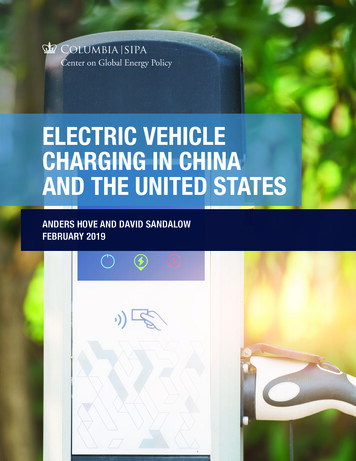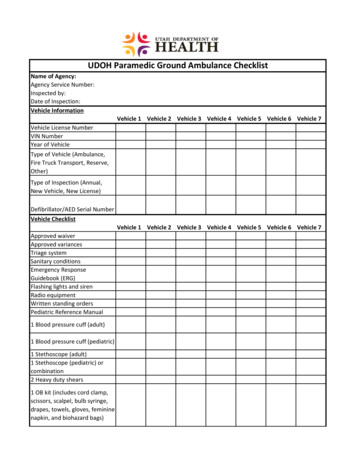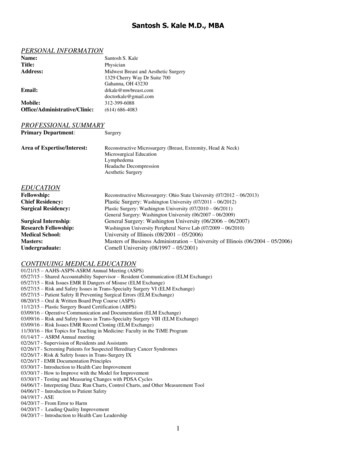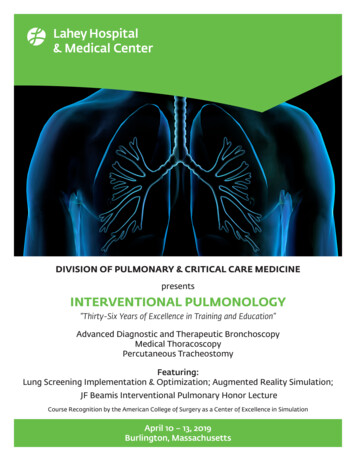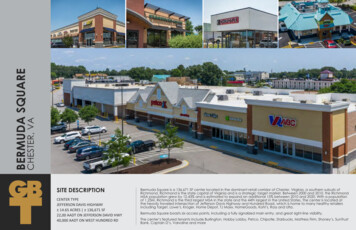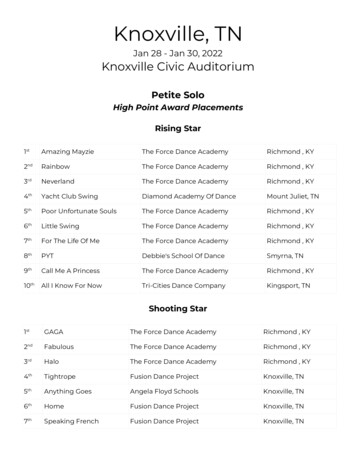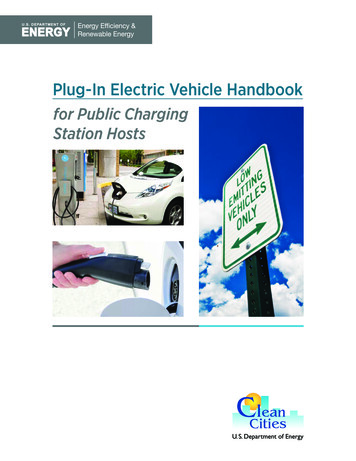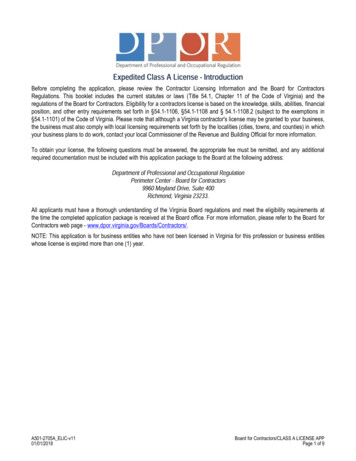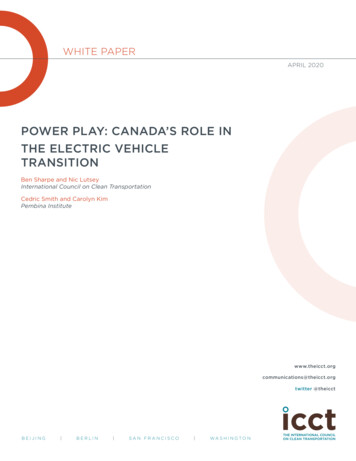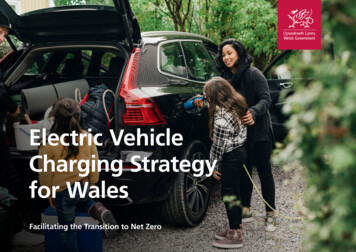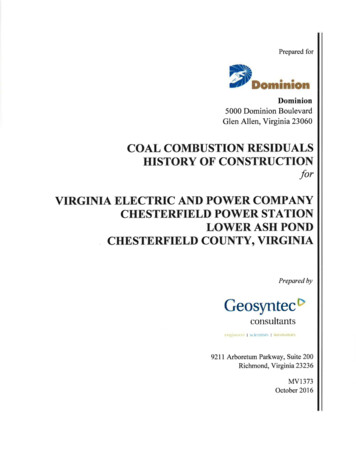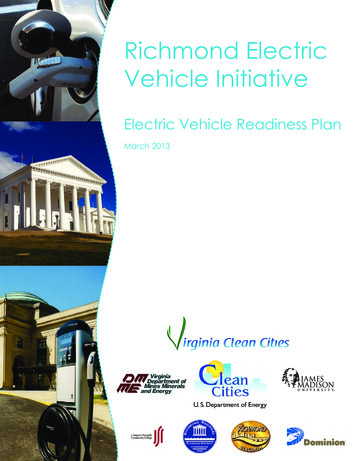
Transcription
Richmond ElectricVehicle InitiativeElectric Vehicle Readiness PlanMarch 2013
Project Funded By:US Department of EnergyFunding Awarded To:Virginia Department of Mines, Minerals and EnergyAl Christopher, Energy Division DirectorDocument Prepared andProject Managed By:Virginia Clean CitiesAlleyn Harned, Executive el Phillips, REVi Project ment Contributors:Dominion Virginia PowerAndrew Flavin, Alternative Energy Policy Research Analyst804-819-2826andrew.j.flavin@dom.comRichmond Regional Planning District CommissionRobert Crum, Executive Director804-323-2033John Fogg, Senior PlannerJ. Sargeant Reynolds Community CollegeCharles Swaim, School of Business Assistant Dean804-523-5023Melissa Gay, Automotive Technology Group Project ManagerSustainable Transportation StrategiesDavid Mayfield, Principaldavid.mayfield@comcast.netThis material is based upon work supported by the Department of Energy under Award Number DE-EE0005550,awarded to the Virginia Department of Mines, Minerals and Energy (DMME).This report was prepared as an account of work sponsored by an agency of the United States Government.Neither the contributors to this program, the United States Government nor any agency thereof, nor any oftheir employees, makes any warranty, express or implied, or assumes any legal liability or responsibility forthe accuracy, completeness, or usefulness of any information, apparatus, product, or process disclosed, orrepresents that its use would not infringe privately owned rights. Reference herein to any specific commercialproduct, process, or service by trade name, trademark, manufacturer, or otherwise does not necessarilyconstitute or imply its endorsement, recommendation, or favoring by the United States Government or anyagency thereof. The views and opinions of authors expressed herein do not necessarily state or reflect those ofthe United States Government or any agency thereof.Richmond Electric Vehicle Initiative Readiness Plan 1
Table of ContentsExecutive Summary.6Key Recommendations.8Project Overview.10Process Overview. 11Advisory Board. 11Working Groups. 11The Electric Vehicles. 12EV Charging Infrastructure. 13EV Charging Scenarios. 14Home Charging. 14Workplace Charging. 14Public Charging. 15DC Fast Charging. 15Barriers. 15EV Deployment in Richmond Area.16Existing EV Infrastructure. 16Plans for EV Infrastructure Deployment. 17Population and Growth. 19Zoning, Codes and Permitting to Advance EV Deployment.22Zoning Guidelines. 22Building Code and Permitting Compliance. 23Building Permit Recommendations. 23Building Permit Processing. 24Ordinance and Development Guidelines. 25Electric Charging Station Layout Recommendations. 26Signage Guidelines and Recommendations. 29General Service Signs. 29Additional Regulatory Signs and Plaque Sizes. 30Current Status of Codes and Permitting Activities. 31Policies and Incentives.32Introduction. 32Richmond Electric Vehicle Initiative Readiness Plan 2
Federal Government. 32Plug-in Vehicle Tax Credit. 32Alternative Fueling Infrastructure Tax Credit. 32Federal Highway Rights of Way. 32State Government. 33Background. 33Emissions Inspections. 33HOV Lane Exemptions. 34Electrical Inspection Jurisdiction. 34Virginia Transportation Funding. 35Local Government. 35Regional Funds for EV Infrastructure. 35Parking Enforcement. 35Personal Property Tax. 37Conclusion. 37Pilot Programs and Other Opportunities.38Time-of-Use Rate Pilot Program. 38Workplace Charging Pilot Program. 39EVSE and Vehicle Leasing/Financing. 39Potential Pilot with Renewable Energy. 39Promoting Workplace Charging. 39Level of Charge. 40Cost of Charging and Payment Collection. 40Controlled Access. 40Charging Rotation. 41Human Resources Considerations. 41Liability Concerns. 41Promoting Charging for Multi-unit Housing. 41Education and Outreach.43Introduction. 43Training. 43Technical Training for Our Future Automotive Technicians. 43EV Education and Training for the Greater Community. 45Jumpstarting EV Awareness: Outreach and Communications. 46Grassroots Outreach. 46Starting an EV Car Club. 46Internet Outreach. 47Social Media and Digital Advocates. 47Richmond Electric Vehicle Initiative Readiness Plan 3
Phone Campaigns. 49Earned Media Campaign. 49Events. 50Strategic Meeting and Conference Presentations. 52Student Outreach. 52Business Case for EV Charging Stations. 52Tax Credit Workshop. 53Networking. 53Marketing Materials. 54Video. 54Informational Handouts. 54Give-away Products. 55Summary of Education and Outreach. 55Conclusion. 56Works Cited. 57Acknowledgments. 58Appendix 1. EV Charging Station Installation Checklist. iAppendix 2. EV Charging Station Site Selection Checklist Handout. iiAppendix 3. Case Study: Business Case for EV Charging Stations. iiiAppendix 4. REVi Earned Media Examples. ivList of TablesTable 1: SAE Standardized Charging Levels. 14Table 2: Generalized Zoning Classifications. 23Table 3: Recommended Minimum EV Parking Spaces. 24Table 4: Recommended Minimum Accessible Charging Stations. 24Table 5: VDOT-Approved EV Charging Sign Specifications. 29Table 6: Details of Informational and Regulatory Signage. 30Table 7: Details of Directional and Charging Station Signage. 31Table 8: Sample Networking Events. 54Table 9: Types of Informational Handouts. 55Richmond Electric Vehicle Initiative Readiness Plan 4
List of FiguresFigure 1: Area Covered by the Richmond Electric Vehicle Initiative. 10Figure 2: Electric Vehicle Types. 12Figure 3: Electric Vehicle Supply Equipment. 13Figure 4: Existing EV Charging Stations. 16Figure 5: Year 2010 HEV Registrations. 17Figure 6: September 2012 Registrations of HEVs and PEVs. 18Figure 7: Regional Median Household Income. 19Figure 8: Regional Population Density and Development Centers. 20Figure 9: Future Development Centers Compared with Existing Population and Development Centers.20Figure 10: Projected EV Growth Areas and Infrastructure Locations. 21Figure 11: Example of 90-Degree EV Parking Adjacent to Sidewalk. 27Figure 12: Adapting Parking Spaces within a Parking Lot. 27Figure 13: Example Layout for On-Street Parallel Parking. 28Figure 14: EV Charging Stations in Parking Structures. 28Figure 15: VDOT-Approved EV Charging Signs. 29Figure 16: VDOT-Approved Directional Signage. 29Figure 17: EV Informational and Regulatory Signage. 30Figure 18: Recommended Directional Signage for Use outside VDOT-Controlled Right-of-Way.30Figure 19: Brochure Used to Market Course. 45Figure 20: Virginia Clean Cities Facebook Page. 48Figure 21: Example Tweet. 48Figure 22: Example Media Clip. 50Figure 23: Focus Electric at Richmond International Raceway. 51Figure 24: First Official EV Plug-in with Mayor Dwight Jones. 53Richmond Electric Vehicle Initiative Readiness Plan 5
Executive SummarySetting the Stage: The Richmond Region’s Case for EVsAdoption of electric vehicles (EVs) is becoming a reality in the Richmond Region and throughout theCommonwealth of Virginia. The region is well-positioned geographically and economically to participate inthis emerging transportation technology. Embracing EV use in Virginia will assist statewide efforts to reducevehicle emissions, increase energy independence, and generate positive economic development for theCommonwealth.Virginians spend 13 billion each year on petroleum for transportation. Electricity represents a less expensive,cleaner, and locally generated energy source that also contributes to new economic advantages. The energyindustry research group PRTM Management Consultants has estimated that vehicle electrification couldrepresent more than 250 billion in economic development opportunities worldwide by 2020. This estimateconsiders growth in electricity generation and distribution, grid and infrastructure investments, batteries andtheir components, vehicle sales, and associated advertising and marketing services.The OpportunityVirginia’s economy is already benefiting from the electric vehicle value chain. Local companies make batteries,battery components, motors, charging stations, and entrepreneurial wireless charging technology. Companiesin Virginia also design, manufacture and deploy electric vehicles, and convert vehicles to plug-in hybrids andbattery electric vehicles. Virginia entities are researching vehicle conversions, assessing charging capacity,reviewing financial strategies, and considering roles in jump-starting vehicle adoption and infrastructuredeployment to further benefit our local economy.The Richmond Region is at the forefront of emerging transportation modes and technologies, and is particularlysupportive of EVs. For example, Ford Motor Company selected Richmond as one of the nineteen US cities tolaunch its first electric car, the Focus Electric; and the area has seen many other EVs come to market since then.Dominion Virginia Power is piloting time-of-use rates to encourage off-peak EV charging.BarriersBarriers to the adoption of EVs include misconceptions about vehicle technologies, the need for more EVcharging infrastructure, and the need for common guidelines that support an easily understood, regionaldeployment of EV infrastructure. Through the Richmond Electric Vehicle Initiative (REVi), teams formed toaddress these barriers. After researching existing conditions, the teams analyzed the technological, regulatory,and educational needs to implement this plan.Richmond Electric Vehicle Initiative Readiness Plan 6
The Richmond Region’s EV Readiness PlanRichmond’s commitment to advancing emerging, cleaner fuels is evident through its participation in theUS Department of Energy’s Clean Cities Community Readiness for Plug-In Electric Vehicles and ChargingInfrastructure program. The REVi plan for plug-in EVs and charging infrastructure details a pathway foradvancing the region as an attractive and sustainable market for EV technology and demonstrates the progressmade to date.The REVi plan first sets the context for the electric vehicle market in the Richmond area and then addresses fivemain topics:1. A regional plan and underlying strategy for deployment of EV charging stations.2. Zoning, codes and permitting tools identified to foster deployment of electric vehicles provide safetyand convenience to the public.3. An analysis of existing and potential policies.4. A report on pilot programs and other opportunities that documents recent work completed, workunderway, and new ideas for action.5. Documentation of over a dozen approaches to education and outreach already undertaken andrecommendations for future outreach and training.Richmond Electric Vehicle Initiative Readiness Plan 7
Key RecommendationsOrganizational Facilitate an advisory board of representatives from organizations with a stake in EV and infrastructuredeployment. The advisory board provides technical expertise and assists with promotion of planrecommendations.Facilitate and engage a diverse list of partner organizations to strategize and provide input throughoutall planning sectors.Codes, Permitting and Site Installation Support creation of a basic network of EV charging stations throughout the Richmond Region.As a building permit requirement for new parking facilities, require that a percentage of the parkingspaces include EV charging stations or conduit for future EV charging stations. The percentages wouldvary according to land use type as detailed in the REVi report.Concentrate higher numbers of EV charging stations where most population density, development,and jobs will be located.Strive for common regional zoning and development guidelines using examples found in this report.Adopt unified signage for locating and identifying charging stations, and regulating EV parking.Policy and Incentives Support tax credits that advance EV and infrastructure purchases and deployment.Encourage adoption of regulations that enable public and private EVSE providers to charge for theirservice.Support HOV lane exemptions for EVs.Support regional funding of publicly accessible EVSE in key locations around the Richmondmetropolitan area.Include the cost of EVSE materials and installation in vehicle financing arrangements from vendors.Support time-of-use charging and other special rate strategies that advance EV deployment.Education and Outreach Create and carry out a coordinated outreach strategy to inform and motivate people to adopt theemerging technology.Target outreach to businesses and government agencies to promote installation of workplace chargingstations.Utilize social media to create a community of advocates.Establish an earned media campaign including public events and testimonials from early adopters totake the EV message to the public at-large.Richmond Electric Vehicle Initiative Readiness Plan 8
Establish and promote training programs for the automotive industry, first responders, corporationsand the general public.Market the EV message by creating a local video, handouts and other materials to present at meetingsand on public access services including cable networks and Internet.As this Clean Cities sponsored project concludes, our stakeholder coalition is ready to move forward using theinformation developed and promote action on these key recommendations. The Richmond Region is the firstarea in Virginia to develop an EV deployment plan. It is the hope of REVi that these recommendations becomea framework that benefits localities across the Commonwealth while they enact their own unique plug-inelectric vehicle and infrastructure planning.Richmond Electric Vehicle Initiative Readiness Plan 9
Project OverviewA consortium of organizations in the Richmond, Virginia region established the Richmond Electric VehicleInitiative (REVi) with the goal of fostering full-scale EV adoption. The Greater Richmond Region is at theforefront of emerging transportation modes and technologies, and is particularly supportive of EVs. This isevident through REVi’s pursuit and award of the US Department of Energy Clean Cities’ Community Readinessand Planning for Plug-in Electric Vehicles and Charging Infrastructure project, which has funded the workpresented in this document. This community readiness and planning project is intended to facilitate theadoption of EVs and associated infrastructure in the Richmond Region and to serve as an example for othercommunities. The area covered by the REVi project is shown in Figure 1, as well as the Crater Planning Districtlocalities.Figure 1: Area Covered by the Richmond Electric Vehicle InitiativeThe resulting work has advanced planning for the Richmond Region as an attractive and sustainable marketfor EVs, established the educational groundwork for EV adoption, and developed a regional strategic plan thatidentifies and fosters policies to expedite EV infrastructure implementation specific to the Richmond Region.EV deployment in Virginia will assist statewide efforts to reduce vehicle emissions, increase energyindependence, and generate positive economic development for the Commonwealth. This plan is a criticalmilestone in moving the Commonwealth one step closer to a balanced energy portfolio for transportation.Richmond Electric Vehicle Initiative Readiness Plan 10
Process OverviewThis project was made possible by funding through the US Department of Energy’s Clean Cities Program. TheVirginia Department of Mines, Minerals and Energy was the prime award recipient, with Virginia Clean Citiesserving as the award administrator and overall program manager. A nine-member Advisory Board focused onprogram goals while several working groups and technical advisory groups addressed plan development.The program assembled significant partnership. It started with over 50 engaged organizations and increasedsubstantially throughout the project. Stakeholder groups participated in many forums to help conduct studiesand analyses, as well as plan and implement project objectives. Localities represented in REVi include the Townof Ashland, the City of Richmond, and the counties of Charles City, Chesterfield, Goochland, Hanover, Henrico,New Kent and Powhatan, as defined by the Richmond Regional Planning District Commission. Other nearbylocalities, including the Crater Planning District Commission municipalities, participated in project efforts.Advisory BoardVirginia Clean Cities created a REVi Advisory Board, bringing together representatives from the Department ofMines, Minerals and Energy, City of Richmond, Dominion Virginia Power, Richmond Regional Planning DistrictCommission, J. Sargeant Reynolds Community College, the Sustainable Transportation Initiative of Richmond,Virginia Commonwealth University and Urban Grid Solar. This advisory board facilitated achievement ofprogram goals by providing input on key success factors, program direction and decision points.Working GroupsMembers of the REVi Advisory Board also led the four project working groups, described below.Codes and Permitting Working Group:This working group, convened by the Richmond Regional Planning District Commission (RRPDC), addressedpotential barriers associated with the installation of charging stations, specifically related to buildingcodes, standards and processes. Their contributions included permitting process documentation and codesrecommendations.Sites and Installation Working Group:The RRPDC led this working group. It focused on the issues and tasks necessary to install a chargingstation, from the technical to the managerial. The working group also participated in planning for future EVinfrastructure.Education and Training Working Group:J. Sargeant Reynolds Community College (JSRCC) led the Education and
Charles Swaim, School of Business Assistant Dean 804-523-5023 Melissa Gay, Automotive Technology Group Project Manager Sustainable Transportation Strategies David Mayfield, Principal david.mayfield@comcast.net This material is based upon work supported by the Department of Energy under Award Number DE-EE0005550,
